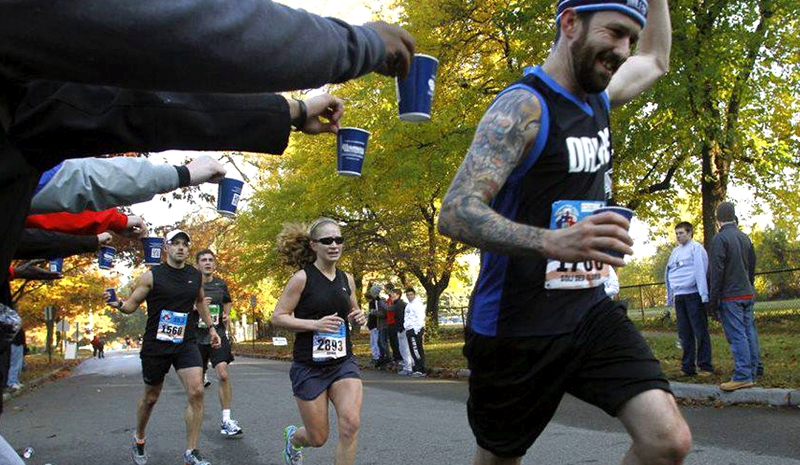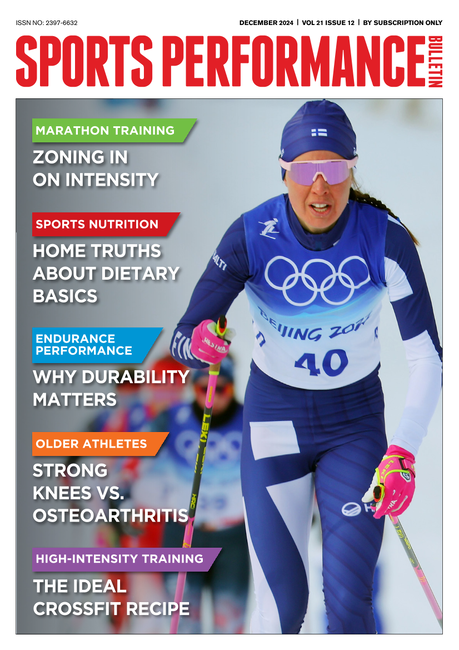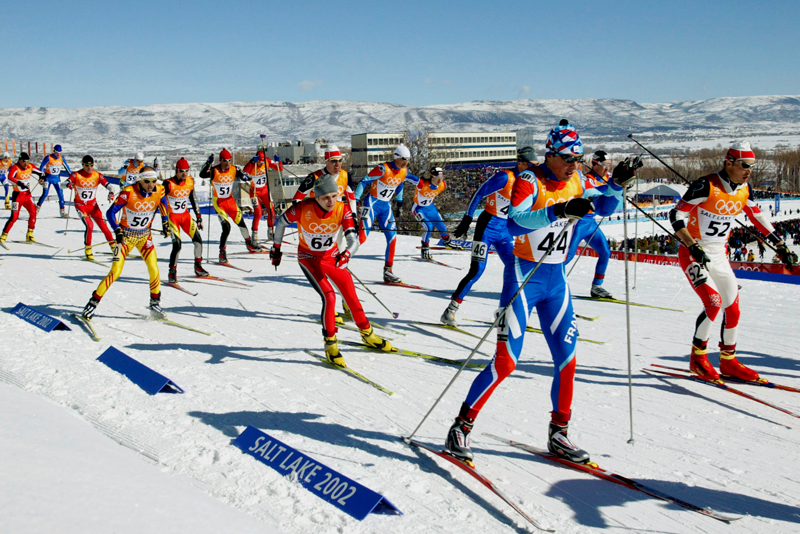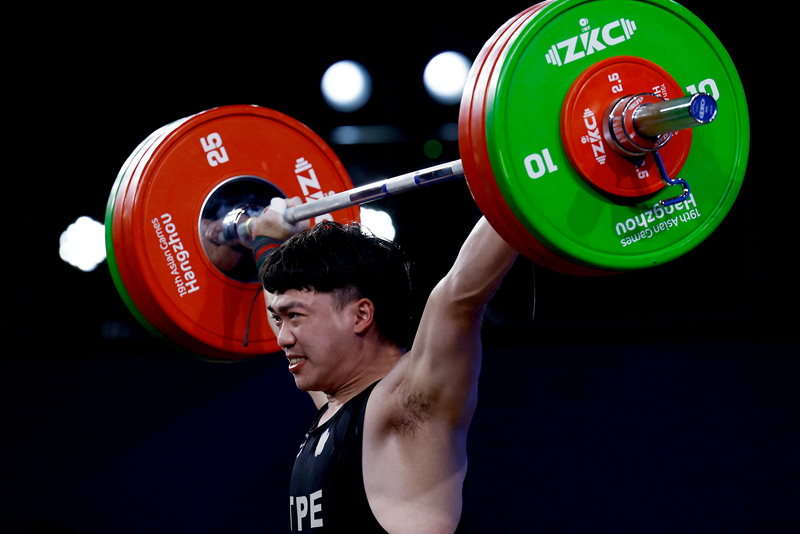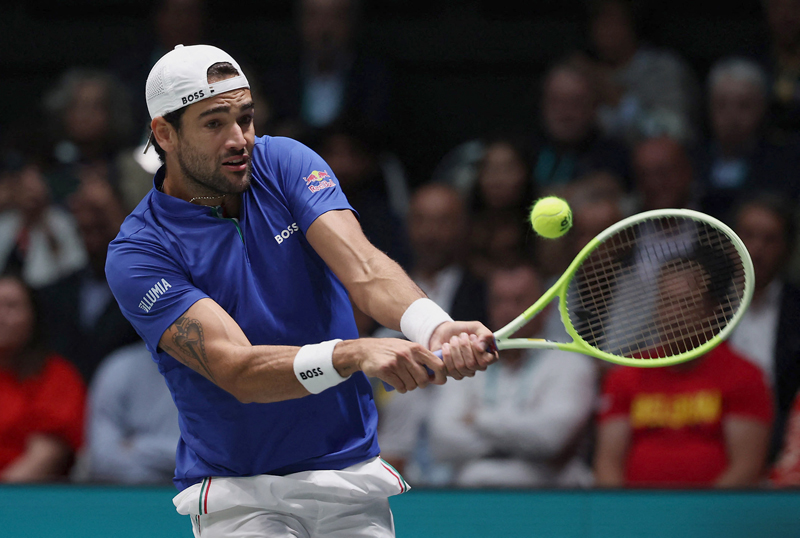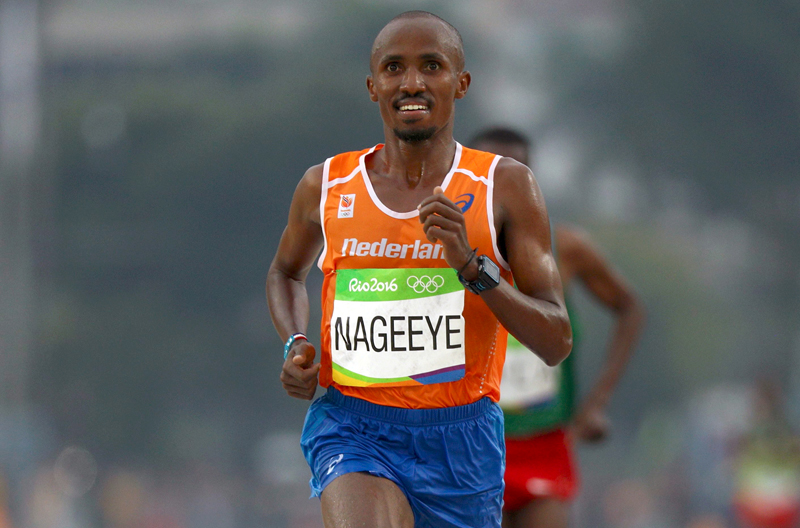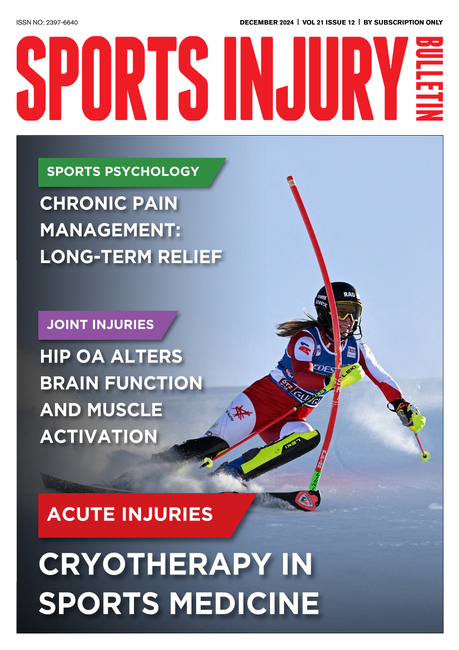You are viewing 1 of your 1 free articles. For unlimited access take a risk-free trial
Sports drinks or water: what's best for hydration and performance?
Your body might appear solid, but it’s actually much more like a bag of salty water, containing a few bones to maintain its shape. Water accounts for around 70% of your body weight – that’s eight stone of water in an 11-stone adult! However, the loss of even a tiny fraction of this water can significantly reduce your performance, which is why maintaining good hydration is vital for all serious athletes.
Water is the medium in which the biochemistry of the body takes place. Every one of our trillions of cells both contains and is bathed in a watery medium. It’s hardly surprising, therefore, that we have developed mechanisms for keeping the water content of the body pretty constant. Because some water is continually being lost in urine (in the process of excreting waste products), a constant throughput of water is required to maintain fluid balance. This balance is controlled principally by the kidneys and the thirst mechanism. When total body water drops, hormonal messages are sent to the brain to create thirst. Excessive water intake, on the other hand, stimulates an increase in urine production.
As well as providing the perfect chemical environment for our bodies, water has another extraordinary property – the ability to stop our bodies overheating by evaporating via the skin in the form of sweat. This is particularly important during exercise, when heat output rises dramatically.
At rest, the average 70kg adult consumes around 0.25 litres of oxygen per minute, which equates to about 70 watts of heat output. But when running at six-minute-mile pace, oxygen consumption rises 16-fold to over four litres per minute and heat output rises to over 1,100 watts! Unless the ambient temperature is sufficiently low, this extra heat cannot be radiated or carried away through convection quickly enough to prevent heat build-up, so heat loss via evaporative cooling (ie sweating) has to occur.
For a 70kg runner running at this pace, the approximate energy burn rate is around 1,000kcal per hour. In warm conditions it would take over 1.5 litres per hour of sweat evaporation to remove the extra heat generated. When you take into account the fact that some sweat will drip off the skin without contributing to evaporative cooling, it is easy to see how runners can lose two litres of fluid per hour or more in hot conditions. And since fluid losses of just 2% of body weight (that’s 1.5 litres from our 70kg runner) can cause a significant drop in performance, our mythical runner could be in trouble in less than an hour without taking extra fluid on board!
Because even small losses of water can cause a drop in performance, optimum hydration is extremely important to athletes. However, replacing fluid lost in sweat and urine is not the only justification for boosting fluid intake. Glycogen (stored muscle carbohydrate) is the body’s principle fuel for high intensity activities, and replenishing glycogen stores with dietary carbohydrate is vital to continuing high performance.
But the process of ‘fixing’ carbohydrate into muscles in the form of glycogen also requires water; each gram of glycogen fixed into muscle fibres requires around 3g of water, which is why you often feel thirsty after a high-carbohydrate post-training meal. If you don’t drink to aid this process, water is simply drawn out of the bloodstream, leading to dehydration.
Fluid, then, is vital for adequate recovery – not just to replace water lost through sweating, but also to help replenish lost glycogen.
A comprehensive hydration strategy involves ensuring good hydration before training/ competition, maintaining it during exercise and then replacing any shortfall as soon as possible afterwards. However, hydration isn’t just about water: fluid loss via urine and, especially, sweating involves the loss of electrolyte minerals – calcium, magnesium, sodium, potassium and chloride. Although the composition varies from person to person (partly as a function of acclimatisation) a litre of sweat typically contains the following (1,2):
- Calcium – 0.02g
- Magnesium – 0.05g
- Sodium – 1.15g
- Potassium – 0.23g
- Chloride – 1.48g
- Although the amounts lost in sweat are generally small in proportion to total body stores, prolonged heavy sweating can lead to significant mineral losses (particularly of sodium). Drinking pure water effectively dilutes the concentration of electrolyte minerals in the blood, which can impair a number of normal physiological processes. An extreme example of such an impairment is ‘hyponatraemia’, when low plasma sodium levels can be literally life threatening.
- Drinks containing electrolyte minerals – particularly sodium – are known to promote thirst, thereby stimulating a greater voluntary intake of fluid (3). There is also evidence that drinks containing sodium enhance the rate and completeness of rehydration after a bout of exercise(4).
- When the electrolyte minerals – again particularly sodium – are present in appropriate concentrations, the rate of fluid absorption from the small intestine into the rest of the body appears to be enhanced, especially in conjunction with small amounts of glucose (5). This is particularly important when rapid uptake of fluid is required, such as during strenuous exercise in the heat.
As for post-training/competition rehydration, the most reliable indicator is body weight, and your fluid replacement needs are considered in detail on page 6 of this issue. Research evidence suggests that fluids containing significant amounts of electrolytes (especially sodium) have a slightly greater impact in restoring hydration than fluids with little or no electrolytes/sodium(6).
However, the amount of sodium in the drink is critical. American scientists compared rehydration efficiency using each of the following (7):
- a 6% carbohydrate solution with no added sodium;
- a 6% carbohydrate solution with 25mEq (0.58g) of sodium per litre;
- a 6% carbohydrate solution with 50mEq (1.16g) of sodium/L.
Although many athletes fail to get it right, maintaining optimum hydration before and after exercise is a relatively straightforward process. Staying hydrated on the move, however, is a different story. When fluid losses are rapid (ie in hot, humid conditions), large amounts of fluids need to be absorbed quickly to maintain hydration status. But hydrating an exercising human body is not as simple as topping up a leaking bucket! The rate of fluid absorption in the body is determined by a two-stage process:
- Gastric emptying – how quickly ingested fluid leaves the stomach. In more dilute solutions, this is often the key step that determines the overall rate of fluid absorption;
- Intestinal absorption – the rate of absorption across the intestinal wall.
Contrary to what you might expect, fluid absorption tends to take place in the small intestine rather than the stomach. Studies have shown that the larger the volume of fluid in the stomach, the more rapid the emptying into the small intestine, which means that maintaining a large fluid volume in the stomach by repeated drinking will maximise the rate of fluid (and nutrient) delivery to the small intestine (8,9).
Gastric emptying rate is also influenced by fluid composition. Early studies showed that, regardless of their electrolyte or glucose content, solutions with a lower overall concentration (or osmolality) than body fluids were emptied as rapidly as plain water (10,11). With glucose solutions, for example, this would allow for a concentration of up to 2.5% (2.5g per litre of water). At the time it seemed that concentrations above this threshold would slow gastric emptying. But more recent work has established that drinks containing glucose concentrations of up to around 4-5% are emptied as rapidly as water (12).
Beyond a concentration of 5%, glucose solutions are emptied more slowly from the stomach, but they can nevertheless result in a faster delivery of glucose overall (13). This is because the increase in glucose per unit volume delivered by these more concentrated drinks more than makes up for the reduced volume absorbed; where fluid replacement is of a lesser importance than energy replacement, more concentrated drinks may be preferable.
In recent years, there has been a growing trend towards the use of short chain glucose polymers, such as maltodextrins, in fluid/energy replacement drinks. The theory is that glucose polymers are emptied more rapidly from the stomach than pure glucose.
However, the evidence is far from conclusive and the various studies that have been carried out have reached conflicting conclusions (14-17). This may be because concentrated beverages are known to increase the volume of gastric and intestinal secretions. It’s possible, therefore, that the total volume of stomach contents may have been greater when solutions containing glucose rather than polymers were drunk, even though the amount of the ingested drink remaining in the stomach was the same. This would affect gastric emptying rates (remembering that gastric emptying is more rapid with high volumes of fluid in the stomach).
However, while the evidence that glucose polymers can offer a significant advantage over pure glucose is thin on the ground, there’s almost no evidence to suggest that the emptying rate of polymer solutions is slower than that of free glucose solutions with the same energy content. Indeed, most studies have reported that polymer solutions are generally emptied faster, if not significantly so.
After gastric emptying, ingested fluids are absorbed in the small intestine. Pure water, or very dilute solutions, diffuse readily across the intestine. However, research has shown that dilute glucose/electrolyte solutions with a concentration that is slightly less than that of plasma maximise the rate of water absorption (18). The researchers found that optimum hydration from the intestine was obtained with a solution containing 60mEq (1.38g) of sodium and 111mmols (20.0g) glucose per litre of water.
Where energy (ie glucose) replacement is the main goal, studies have shown that uptake from the small intestine into the body rises as the concentration of glucose rises in the intestine. This is simply because there is more glucose available per unit volume for absorption.
However, very concentrated solutions of glucose (more than 6%) can have an adverse effect on fluid balance. This is due to the process known as osmosis, whereby water separated by a permeable membrane (in this case the intestinal wall) passes from a more dilute to a more concentrated solution. When you ingest a drink with a very high concentration of glucose, the fluid in the bloodstream (on the other side of the intestinal wall) will be relatively dilute by comparison. And the osmotic pressure exerted by the very concentrated glucose solution will actually draw water out of the bloodstream and into the intestine. This results in a loss of available body water, effectively increasing dehydration.
Although it has a chemical structure similar to glucose, the fruit sugar fructose diffuses passively across the intestinal wall. Studies have shown that fructose is absorbed more slowly than glucose and that it promotes less water uptake (19). Moreover, fructose is known to exert a greater osmotic pressure, which means that, for a given concentration, it is more likely to draw water into the intestine, which can cause abdominal distress. These properties make fructose much less desirable as an energy component in sports drinks than glucose.
A study on cyclists compared the effects of glucose and fructose in a 6% solution during a 1hr 45min bout of cycling (20). By comparison with glucose, fructose was associated with more gastrointestinal distress, a greater loss of plasma volume, higher levels of stress hormone and substantially poorer exercise performance!
Properly formulated carbohydrate/electrolyte drinks can and do increase hydration (and, as a bonus, supply extra carbohydrate to working muscles), so it’s hardly surprising that they really do enhance performance when fluid loss is an issue (21-29). But what’s the best strategy for individual athletes? And how do you decide on the best drinks for you? Here are some simple guidelines derived from the evidence referred to in this article:
Pre-exercise
- Make sure your normal diet contains plenty of water and a minimum of other substances known to impair hydration;
- Drink ample (but not excessive) water in the run-up to a training session or event;
- Consider using glycerol for hyper-hydration only if you are an elite athletes undertaking long endurance events in extremely hot conditions. Even then it has its drawbacks.
Post-exercise
- Follow Ron Maughan’s advice on replacing lost fluid in terms of volume;
- Drinks containing electrolytes (especially sodium) stimulate the desire to drink and may therefore be preferable to plain water. There’s also evidence that these drinks are absorbed more efficiently from the small intestine, especially when carbohydrate is present;
- Remember that you’ll need to absorb extra fluid for glycogen replenishment – about 300ml for every 100g of carbohydrate consumed.
Mid-exercise
- For events lasting less than 30 minutes, mid- exercise fluid replacement isn’t necessary, since it’s not possible to lose enough fluid to affect performance in such a short space of time;
- Weather and exercise intensity affect fluid needs; the higher the temperature, humidity and exercise intensity, the greater the rate of fluid replacement required;
- Gastric emptying is most efficient when there is a high fluid volume in the stomach, so your best strategy is to start exercise with fluid on board and drink little and often to keep it topped up;
- Gastric emptying is also affected by the concentration of a drink. As a rule, the more concentrated the drink, the slower it empties;
- Plain water empties rapidly as do low concentration (hypotonic) drinks and isotonic drinks. More recent research also suggests that energy drinks containing up to 4-5% glucose also empty as rapidly as water. However, drinks containing glucose and sodium are absorbed from the intestine more rapidly than plain water;
- More concentrated drinks (more than 6%) leave the stomach more slowly, but still manage to deliver more carbohydrate. Where energy replacement is the priority, these drinks are recommended, although they are less efficient for hydration;
- Where hydration is the priority, water, isotonic or low concentration glucose drinks will all suffice, though hypotonic/isotonic electrolyte/glucose containing drinks may be absorbed more rapidly from the intestine;
- Whatever sports drink you choose, ensure it contains electrolyte minerals;
- Where hydration is your goal, water is okay but high volumes of plain water are not recommended where profuse and prolonged sweating occurs (more than 3-4 litres lost) because of the risk of sodium dilution. If water is your preferred drink, consider using salt tablets in these circumstances;
- The evidence in favour of glucose polymer drinks is mixed. Overall, they may confer a slight advantage in terms of gastric emptying, but be prepared to pay more!
- Fructose or pure fruit juice drinks are not absorbed rapidly and may cause abdominal distress;
- Never experiment with a new drink during competition. Try it in training first to see how your body tolerates it!
- Choose a drink you find palatable. If it doesn’t taste nice, you won’t drink it, no matter how advanced the formula!
Hyponatraemia – the dangers of fluid overload
Hyponatraemia is a disorder in fluid-electrolyte balance that results in an abnormally low plasma sodium concentration (less than 135mmol per litre compared with a normal range of 138-142mmol/L. A sustained decrease in plasma sodium concentration disrupts the dynamics of water exchange (osmotic balance) across the blood-brain barrier, resulting in a rapid influx of water into the brain. This can cause swelling in the brain, leading to a series of increasingly severe neurological responses, such as confusion, seizure, coma – even death.The lower the blood sodium and the faster it falls, the greater the risk of life-threatening consequences. A drop in plasma sodium concentration to 125-135mmol/L often results in little more than gastrointestinal symptoms, such as bloating and nausea. Below 125mmol/L, the symptoms become more severe and can include confusion, throbbing headache, wheezy breathing, swollen hands and feet, unusual fatigue and reduced coordination. Below 120mmol/L, the risk of seizure, coma and death is increased.
Hyponatraemia in athletes is often, although not always, caused by excessive drinking. During exercise, urine production is decreased, reducing the body’s ability to excrete excess water, while at the same time sodium losses are increased through sweating. The combined effect makes it much more likely that the body’s sodium content will be significantly diluted.
Glycerol myths and reality
For most people, taking a glycerol/water solution before an event produces an increase in total body water (hyper-hydration). The question, however, is whether this extra water in the body actually enhances performance, and to date there is no clear-cut evidence to suggest that it does. It is true that after ingestion glycerol stays in the body and holds water with it, but the unanswered question is whether this extra water increases hydration within the cells or simply increases the amount of water swilling around in general circulation?Overall, the current weight of evidence is tilted slightly in favour of a glycerol hyper-hydration protocol, but only in events where substantial dehydration is likely to be a problem. Moreover, there is still no agreement about the best way to take glycerol solution, or about whether certain kinds of plain water hyper-hydration protocols might offer similar benefits.
Unless your event is long and taking place in hot/humid conditions, resulting in unavoidable dehydration, there is probably little point in using glycerol. Not only are there unlikely to be any performance benefits, but glycerol ingestion can cause stomach upsets, together with headaches and blurred vision at higher doses. If you are tempted to try glycerol, make sure you’ve tried other hydration methods first. Glycerol should be considered only as a last resort.
Sports drinks jargon buster
With so many sports drinks on the market, it’s easy to become confused about which type is best suited to your needs. Isotonic, energy and recovery drinks can all be used to promote hydration, but tend to have slightly differing effects, which are explained below. It’s important to understand, though, that these categories can overlap – eg energy drinks containing relatively small amounts of carbohydrate can be almost isotonic – so the distinctions here should serve as a guide only.- Isotonic drinks provide the body with water, energy and electrolytes in a form enabling the water to be absorbed as rapidly as possible. Studies have shown that fluid is rapidly emptied from the stomach when it contains roughly the same concentration of dissolved substances as that of blood serum – a value of 280 milli-osmoles/kg for you technophiles out there! At this concentration, a drink is said to be ‘isotonic’ or at the same concentration as your body fluids. During exercise, energy in the form of carbohydrate, and electrolyte minerals, such as sodium, potassium, calcium and magnesium, are lost along with water. When these substances are dissolved in water at an isotonic concentration they not only help replace lost fluid more rapidly than even plain water but also help replace some of the lost energy and minerals. However, research has demonstrated that drinks containing dissolved glucose at higher than isotonic concentrations (up to 5%) can be emptied from the stomach just as rapidly, and can therefore replace lost energy more rapidly. Although not strictly isotonic, these drinks offer all the fluid replacement benefits of isotonic drinks and are often marketed as such.
- Energy drinks are less about replacing lost fluid and more about keeping the working muscles supplied with energy during very long and sustained workouts. Energy drinks need to contain much higher concentrations of soluble carbohydrates than isotonic drinks, because an isotonic solution of carbohydrate struggles to provide energy at a sufficient rate to replace what is lost during intense exercise. The disadvantage of energy drinks is that their high carbohydrate concentrations tend to slow down the rate of water absorption, particularly during hard exercise. They are therefore best reserved for longer endurance events performed in more temperate conditions, where a very high rate of fluid replacement is not quite so critical.
- Recovery drinks, as the name suggests, are taken after training to supply the muscles with everything they need for recovery, including water, carbohydrate and amino acids. These drinks often contain such additional nutrients as electrolyte minerals, vitamins needed to aid metabolism of the ingested carbohydrate, and protein and more exotic co-factors designed to accelerate recovery. Because they’re taken after training, rapid gastric emptying and absorption is not a priority.
Andrew Hamilton
References
- Geigy Scientific Tables, 8th Ed, Ciba-Geigy Ltd, 1981
- Human Physiology, 2nd Ed, Springer-Verlag, Berlin, 1989
- Appl Physiol 80:1112-1117, 1996
- Int J Sports Nutr 7:104-116, 1997
- Amer J Physiol 258 (Gastrointest. Liver Physiol) 21:G216-G222, 1990
- Medicine and Science in Sports and Exercise, 28:1260-1271, 1996
- International Journal of Sports Nutrition, 15:329, 1997
- Medicine and Science in Sports and Exercise 23:307-313, 1990
- Medicine and Science in Sports and Exercise, 23:314-319, 1990
- J Physiol 154:254-269, 1960
- J Physiol 245:209-225, 1975
- Medicine and Science in Sports and Exercise, 24:S70, 1992
- Gastroenterology 89:1326-1330, 1985
- Res Quart 51:299-305, 1980
- Eur J Appl Physiol Occup Physiol, 58(6):60512, 1989
- Medicine and Science in Sports and Exercise, 18:568-575, 1986
- J Appl Physiol, 72(2):468-75, 1992
- J Pediatr, 106(3):383-9, 1985
- J Clin Invest,55(4):728-37, 1975
- Medicine and Science in Sports and Exercise, 21:275-282, 1989
- Medicine and Science in Sports and Exercise, 27:S223, 1995
- European Journal of Applied Physiology, 70:154-160, 1995.
- Medicine and Science in Sports and Exercise: Vol.27, No. 2:200-210, 1995
- American Journal of Clinical Nutrition, 48:1023-1033, 1988
- Medicine and Science in Sports and Exercise, 20:110-115, 1988.
- Medicine and Science in Sports and Exercise, 31:S123, 1999
- Journal of Applied Physiology, 71(6):2518-2527, 1991
- American Journal of Physiology, 258:G216-G222, 1990
- International Journal of Sports Medicine, 13:399-406, 1992
Newsletter Sign Up
Testimonials
Dr. Alexandra Fandetti-Robin, Back & Body Chiropractic
Elspeth Cowell MSCh DpodM SRCh HCPC reg
William Hunter, Nuffield Health
Newsletter Sign Up
Coaches Testimonials
Dr. Alexandra Fandetti-Robin, Back & Body Chiropractic
Elspeth Cowell MSCh DpodM SRCh HCPC reg
William Hunter, Nuffield Health
Keep up with latest sports science research and apply it to maximize performance
Today you have the chance to join a group of athletes, and sports coaches/trainers who all have something special in common...
They use the latest research to improve performance for themselves and their clients - both athletes and sports teams - with help from global specialists in the fields of sports science, sports medicine and sports psychology.
They do this by reading Sports Performance Bulletin, an easy-to-digest but serious-minded journal dedicated to high performance sports. SPB offers a wealth of information and insight into the latest research, in an easily-accessible and understood format, along with a wealth of practical recommendations.
*includes 3 coaching manuals
Get Inspired
All the latest techniques and approaches
Sports Performance Bulletin helps dedicated endurance athletes improve their performance. Sense-checking the latest sports science research, and sourcing evidence and case studies to support findings, Sports Performance Bulletin turns proven insights into easily digestible practical advice. Supporting athletes, coaches and professionals who wish to ensure their guidance and programmes are kept right up to date and based on credible science.
